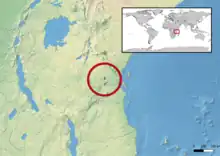Fischer's chameleon
Fischer's chameleon (Kinyongia fischeri), also known commonly as the Nguru blade-horned chameleon and the Nguru two-horned chameleon, is a species of chameleon, a lizard in the family Chamaeleonidae. The species is endemic to Tanzania.
| Fischer's chameleon | |
|---|---|
.jpg.webp) | |
| Drawing of Fischer's chameleons (male above and female in the middle) and Rampholeon brevicaudatus | |
| Scientific classification | |
| Domain: | Eukaryota |
| Kingdom: | Animalia |
| Phylum: | Chordata |
| Class: | Reptilia |
| Order: | Squamata |
| Suborder: | Iguania |
| Family: | Chamaeleonidae |
| Genus: | Kinyongia |
| Species: | K. fischeri |
| Binomial name | |
| Kinyongia fischeri (Reichenow, 1887) | |
 | |
| Synonyms[2] | |
Etymology
The specific name, fischeri, is in honor of German herpetologist Johann Gustav Fischer.[3]
Geographic range
K. fischeri is restricted to the Nguru and Nguu Mountains of Tanzania.[2][4] Chameleons found in other parts of the Eastern Arc Mountains as well as Kenya are now classified as separate species.[4][5]
Habitat
The preferred natural habitat of K. fischeri is forest, at altitudes up to 1,500 m (4,900 ft).[1]
Taxonomy
A number of other species (K. matschiei, K. multituberculata, K. tavetana, K. uluguruensis, and K. vosseleri ) have been mistakenly called by this species' name or classified as subspecies. In 2008, it was shown that they actually are their own, distinct species.[4][5] The true Fischer's chameleon is rare with a more restricted distribution than previously believed.[4][5]
In captivity
Although formerly considered common in captivity, virtually all "Fischer's chameleons" in the pet trade are now known to actually be other species. Only three true Fischer's chameleon are known to have entered captivity.
References
- Tolley, K.; Menegon, M. (2014). "Kinyongia fischeri ". IUCN Red List of Threatened Species. 2014: e.T172565A1345554. doi:10.2305/IUCN.UK.2014-3.RLTS.T172565A1345554.en. Retrieved 20 November 2021.
- Kinyongia fischeri at the Reptarium.cz Reptile Database. Accessed 2 July 2017.
- Beolens, Bo; Watkins, Michael; Grayson, Michael (2011). The Eponym Dictionary of Reptiles. Baltimore: Johns Hopkins University Press. xiii + 296 pp. ISBN 978-1-4214-0135-5. (Kinyongia fischeri, p. 90).
- Mariaux J, Lutzmann N, Stipala J (2008). "The two-horned chamaeleons of East Africa". Zoological Journal of the Linnean Society. 152 (2): 367–391. doi:10.1111/j.1096-3642.2007.00332.x.
- Lutzmann N (2008)."Some important changes in the systematics of Bradypodion FITZINGER, 1843". Chameleons! Online E-Zine. chameleonnews.com
Further reading
- Nečas P (1999). Chamaeleons—Nature's Hidden Jewels. Frankfurt am Main: Edition Chimaira. 348 pp. ISBN 3-930612-04-6 (Europe), ISBN 1-57524-137-4 (USA, Canada). (Bradypodion fischeri, new combination, p. 191).
- Reichenow A (1887). "Neue Wirbelthiere des Zoologischen Museums in Berlin ". Zoologischer Anzeiger 10: 369–372. (Chamaeleon fischeri, new species, pp. 371–372). (in German).
- Tilbury CR, Tolley KA, Branch WR (2006). "A review of the systematics of the genus Bradypodion (Sauria: Chamaeleonidae) with the description of two new genera". Zootaxa 1363: 23–38. (Kinyongia fischeri, new combination).
